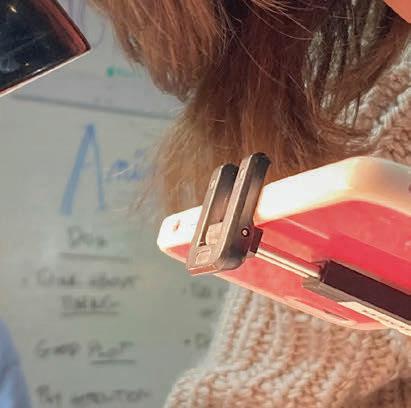SEPTEMBER-NOVEMBER 2024







SEPTEMBER-NOVEMBER 2024







Oct. 17 – Nov. 3 Nov. 8 – 17











Friends,
Welcome to the 2024-25 season of CU Presents!
On behalf of the University of Colorado Boulder College of Music, I’m thrilled to introduce the diverse and enriching experiences that await you.
With a lineup showcasing pinnacles of artistic expression, our current season promises to be extraordinary: The Artist Series—featuring performances from legendary soprano Renée Fleming to the ingenious Martha Graham Dance Company—complements captivating productions from the College of Music’s Eklund Opera and musical theatre programs.
This season, we’re especially excited to celebrate the 50th anniversary of our resident Takács Quartet (page 24) whose mastery continues to inspire audiences worldwide. Additionally, the College of Music is proud to present more than 350 free events this academic year showcasing the talents of our students, faculty and guest artists.
This fall, I invite you to join me in extending warm congratulations to Andrew Metzroth (page 12)—our new executive director of CU Presents— whose leadership promises to bring fresh perspectives and innovative ideas; as well as Rudy Betancourt (page 15) in his expanded role as director of Macky Auditorium and our long-running Artist Series, ensuring memorable experiences for you—our valued patrons.
We believe in the power of the arts to unite and transform. As we gather once again to celebrate creativity and community, let us remember the profound impact of what we do: Through the performing arts, we not only entertain but also enlighten, provoke thought and inspire change. Thank you for your continued support of the College of Music and CU Presents. We look forward to sharing this remarkable season with you.

Enjoy! Dean, College of Music University of Colorado Boulder
06 Spotlight: Hänsel und Gretel
12
24 Takács Quartet: 50 years at CU Boulder
26 Our Supporters
30 CU Presents Personnel
Editors
Laima Haley, Sabine Kortals Stein
Designer Sabrina Green
Contributors
Clay Bonnyman Evans, Adam Goldstein, Sabine Kortals Stein, Henry Michaels, Marc Shulgold
Photo/Image Credits
Glenn Asakawa, CU Boulder Photography, Boston Brass, Damien Bredberg, Patrick Campbell, Casey Cass, Douglass Chatfield, Andrew Eccles/Decca, Ken Jacques, Lisa Mazzuco, Quartet Integra
Cover Images
Artist Series: Circa, photo by Damien Bredberg
Eklund Opera: Promotional art, Hänsel und Gretel Takács Quartet: Photo by Amanda Tipton
The University of Colorado Boulder, Colorado’s flagship university, honors and recognizes the many contributions of Indigenous peoples in our state. CU Boulder acknowledges that it is located on the traditional territories and ancestral homelands of the Cheyenne, Arapaho, Ute and many other Native American nations. Their forced removal from these territories has caused devastating and lasting impacts.
Artist Series Advisory Board: gReg Silvus, Chair; Gil Berman, Donalee Brown, Shirley Carnahan, Mike Gallucci, Alan Halpern, Daryl James, Maryann Jaross, Reiland Rabaka, Erika Randall, Norma Sierra, Ellen Taxman, Ann Yost
Music Advisory Board: Lynn Streeter, Chair; Sue Baer, Howard Bernstein, Dave Bowers, Bob Bunting, Jan Burton, Bob Charles, Marty Coffin Evans, Paul Eklund, Jonathan Fox, Dave Fulker, Grace Gamm, Laurie Hathorn, Doree Hickman, Maria Johnson, Caryl Kassoy, Barbara Miller, Ben Nelson, Susan Olenwine, Rudy Perez, Mikhy Ritter, Becky Roser, Firuzeh Saidi, gReg Silvus, Jeannie Thompson, Jack Walker, Celia Waterhouse
This CU Presents program is published by: The Publishing House, Westminster, CO.
Publisher
Angie Flachman Johnson
Production Manager
Stacey Krull
President Emeritus
Wilbur E. Flachman
For advertising, call 303-428-9529 or email sales@pub-house.com. ColoradoArtsPubs.com














By Adam Goldstein
Engelbert Humperdinck’s 19th-century opera Hänsel und Gretel is hardly the simple stuff of fairy tales.
That may seem like a contradiction for audience members taking in their first performance of the beloved opera based on the familiar folk tale. Like the well-known story, the opera follows the trials of two siblings who get lost in the woods and ultimately run afoul of a witch.
Humperdinck, the German composer of the opera (who just happens to share a name with the British pop singer who achieved fame in the 1970s) described it himself as a
“ Märchenoper ,” quite literally a “fairy tale opera.”
But those attending the Eklund Opera Program’s performance of the opera may be surprised. According to Leigh Holman, stage director for the production and director of the Eklund Opera Program, the piece defies expectations.
“If someone has never seen it before, they might think it’s a children’s composition with sing-songy pieces,” Holman says. “Humperdinck’s musical idol was Richard Wagner, who’s known for big, sweeping orchestral arrangements and themes that
recur. That’s all to give the idea of the sumptuousness of the piece, the variety of the piece, the depth of it.”
“It’s a lot more glorious than we might think,” Holman adds.
The opera’s scope, scale and ambition are part of what’s made it a perennial favorite among operagoers of all backgrounds for more than a century. With its demanding and evocative music shared by the lead mezzo soprano and high soprano (Hänsel and Gretel, respectively), and the witch’s score sung by a mezzo soprano or a tenor, the opera offers a blend of voices that truly summons character and conflict.
The vocals find a complement in the lush orchestration of the piece, as well as the dynamic staging—from a ballet featuring 14 dancers representing angels to a final, dramatic conflict with the witch, Hänsel und Gretel offers plenty in the way of stagecraft.
All of this is to say that the opera has long encapsulated the most grandiose elements of opera—the larger-thanlife music, costumes, sets and action.
This makes it ideal for audiences, and for relatively new performers taking their first steps in the world of opera.
“Our orchestra is made up of students. To be able to work on a piece like this that is so grand—it’s difficult, but our students are up for it, for sure,” Holman says, adding that the piece is a favorite of Music Director Nicholas Carthy. “The major roles are all done by grad students. It requires large voices and people who are adept at reading challenging music.”
(Story continues on page 13)














Circa
Duck Pond
Oct. 5, 2024

Pablo Sáinz-Villegas
Guitar Masterworks
Nov. 9, 2024

Boston Brass + Brass All-Stars Big Band
Christmas Bells are Swingin’
Dec. 14, 2024

Renée Fleming
Voice of Nature
Jan. 31, 2025
Hänsel und Gretel
An opera by Engelbert Humperdinck
Oct. 25 and 27, 2024
Heathers: The Musical Book, Music and Lyrics by Laurence O’Keefe and Kevin Murphy
Nov. 14-17, 2024
Holiday Festival 2024
Boulder’s beloved holiday tradition
Dec. 6-8, 2024
50th Anniversary Season


Takács Quartet
Sept. 15 and 16, 2024
Oct. 13 and 14, 2024
Jan. 12 and 13, 2025
All performances stream for one week after Monday concert.
Quartet Integra
Nov. 3 and 4, 2024
Performance streams for one week after Monday concert.
Peter Cooper, oboe | Aug. 27
The Oboe as Vocalist
Jennifer Hayghe, piano | Sept. 3 Circumnavigation
Ryan Gardner, trumpet | Sept. 10
Margaret McDonald, piano | Sept. 17
The student becomes the teacher
Nathan Mertens, saxophone | Sept. 24
A Celebration of Japanese Saxophone
Nicolo Spera, guitar | Oct. 1 With ITER Research Ensemble
Yoshi Ishikawa, bassoon | Oct. 8
With Pan Pacific Wind Quintet
Lillian Gordis, harpsichord | Oct. 15
Solo harpsichord works by J.S. Bach
Alejandro Cremaschi, piano | Oct. 22
Palimpsest: Folk Traditions Through New Music
Abigail Nims, mezzo soprano and Mutsumi Moteki, piano | Oct. 29
Composition and Saxophone Faculty | Nov. 5
With the ~Nois Saxophone Quartet
Andrew Cooperstock, piano | Nov. 12
Meta Weiss | Dec. 3
With Daniel de Borah, piano
The University of Colorado is committed to providing equal access to individuals with disabilities.
LEARN MORE at this QR code, or visit cupresents.org/accessibility
Coming to a show and need accomodations? Contact CU Presents at least seven (7) days before the event at either cupresents@colorado.edu or 303-492-8008.
Make sure you can enjoy the show! Guaranteed valid tickets can be purchased:
• Online at cupresents.org
• From our box office at the University Club
• By phone at 303-492-8008
Ticket sales are final; no refunds. Exchanges are subject to availability and must be made at least one business day prior to the day of performance.
Latecomers are seated at the discretion of the house manager. You may be seated in a seat other than your ticketed seat; you can move to your ticketed seat during intermission.
Late seating is unavailable in the:
• Music Theatre (Imig Music Building)
• Loft Theatre (University Theatre Building)
CU Boulder is smoke-free.
7:30 P.M. | GRUSIN MUSIC HALL FREE AND OPEN TO THE PUBLIC
Photography and video / audio recordings of any type are PROHIBITED during the performance.










Bee-Friendly,
Friday,
Stewart
Saturday, Nov. 16 at 7p
Congregation Nevei Kodesh, Boulder
Sunday, Nov. 17 at 3p
St. Thomas Episcopal Church, Denver







By Sabine Kortals Stein
Andrew (“Metz”) Metzroth can’t contain his joy when he talks about his new job as executive director of CU Presents, effective since Aug. 5. “I’ve worked toward this for a decade—it’s truly exciting,” he enthuses. As part of the University of Colorado Boulder College of Music, CU Presents is the home of performing arts on campus annually presenting hundreds of events by CU Boulder students and faculty, as well as world-famous guest artists.
Overseeing CU Presents requires administrative skill, a steady hand and a cool head. Just consider the competition Metzroth had to contend with after longtime director Joan Braun retired at the end of last season.
“I’m happy that the College of Music conducted a national search,” says Metzroth. “I think there were about three dozen applicants.” But one look at his résumé and it’s not surprising that Metzroth landed the position.
For starters, his years of experience in nearly every aspect of the theater— backstage, onstage, above-stage, you name it—is mind-boggling. As his local credits will attest, he’s been everywhere at CU Presents for decades. Plus, his enthusiasm is contagious.
“I’ve always had a love for the theater,”
he says. As for his relationship with CU Boulder, he became box office manager in 2007, handling ticketing for campus performing arts events for nine years. That’s no small task, he emphasizes: “The ticketing software [Tessitura] goes incredibly deep, and takes a long time to learn and teach.” Moving further up the ladder, he became director of operations at CU Presents in 2017.
Today, Metzroth’s responsibilities entail close involvement in managing the Artist Series in Macky Auditorium and Takács Quartet concerts in Grusin Music Hall. But there are more shows to handle—a lot more. “There are some 450 on-campus events including about 350 College of Music events, 50 Theatre & Dance Department events and 50 Colorado Shakespeare Festival performances,” he explains. “I’ll be involved in strategy, ticketing, and marketing and communications for all our series, particularly College of Music events. You have to know what’s important to all of them, to know their goals.”
Not that he intends to remain invisible. “I never want this to be a desk job,” stresses the four-time CU Boulder alumnus. “I see myself as a community ambassador—I want to bring audiences into performing arts experiences.”

( Hänsel und Gretel : continued from page 6)
For its impressive scope, the piece also holds an allure to modern audiences of all backgrounds and ages. At a running time of a little more than two hours with intermission, it’s an ideal length for children, teens and firsttime operagoers. The libretto, penned by Humperdinck’s sister, is entirely in German, but the production in Macky Auditorium will include supertitles in English for an accessible story.
That combination of accessibility and sheer scope is part of what has made Hänsel und Gretel a favorite for more than a century for both audiences and artists alike; it’s also what’s bound to defy the expectations of those who only know a simple, straightforward version of the old story.
































































































































Macky Auditorium Director Rudy Betancourt takes over as director of CU Boulder’s beloved Artist Series
By Clay Bonnyman Evans
After almost 15 years at the helm of Macky Auditorium at the University of Colorado Boulder, Rudy Betancourt has also been named the new director of the long-running Artist Series which has brought the finest jazz, classical, world music and dance performers to town for more than eight decades.
Betancourt—a native of Venezuela and an accomplished classical guitarist— will continue to serve as director at Macky which welcomes more than 100,000 people to over 100 events every season. He says adding the
beloved series to the venue’s portfolio has the potential to turn over a new page for both.
“The Artist Series has been evolving for decades with an unparalleled cultural impact,” he says. “Having the Artist Series within Macky’s portfolio helps the venue to be a presenter as much as a facility for rent.”
Betancourt says the Artist Series will continue to delight long-time patrons as it also seeks to expand and diversify its programming.
“The series will still include dance, classical music, jazz, performing arts from all over the world, as well as new genres. Keeping true to its well-established mission while feeling the cultural pulse in Boulder will help determine its evolution,” he says. “There will be wonderful choices for our legacy and new audiences to enjoy.”
When CU Presents Executive Director
Joan Braun retired at the end of June after 30 years, it was determined that it made sense to separate the curation of the Artist Series from the operations of CU Presents. Braun and CU Boulder College of Music Dean John Davis recommended Betancourt to be the Artist Series director as the most natural choice.
“Rudy is an excellent, accomplished musician and he has impeccable taste and awareness of the music scene,” Braun says. “As director of Macky, he also is very aware of audience tastes and preferences, and what they respond to. He can see some different pathways and possibilities and I’m excited to see what he does with it.”
“Joan’s legacy of innovation in the arts and securing the Artist Series’ place in the hearts of its audiences is a tall order—one that I am honored to continue. I am excited to work with the College of Music’s leadership and the Artist Series Advisory Board. It is a real privilege,” Betancourt says.
Betancourt will continue to work closely with the staff at CU Presents. “The CU Presents team brings unparalleled knowledge of how to reach our audiences and cultivate our relationship with them,” he says.
“Continuing and deepening this collaboration will be paramount to the success of the series.”
CU Presents will continue to work with other College of Music programs as well as with the Colorado Shakespeare Festival and CU Theatre & Dance.
Tickets for the 2024-25 Artist Series are on sale now.




By Marc Shulgold
For any composer in the 18th century, Haydn’s professional life must have sounded like a dream come true: nearly 30 years of service in the palace of Hungary’s music-loving Prince Nikolaus Esterházy and his family. There, he enjoyed a salary, regular meals, spacious living quarters, an orchestra at his disposal and two theaters for performing his operas. Haydn certainly relished his good fortune. “Not only did I have the encouragement of constant approval,” he told his friend and biographer Georg Griesinger, “but as conductor of an orchestra I could make experiments, observe what produced an effect and what weakened it. … I was cut off from the world; there was no one to confuse or torment me, and I was forced to become original.”
There is originality in abundance throughout the dozens of string quartets Haydn composed at the palace— perhaps none more so than in the second of three quartets of Op. 54, written in 1788. Writing them was one thing, but because of the isolation of the Esterházy palace, getting them out to the world was quite another. Unable to travel in search of a publisher, the composer deputized Johann Tost, leader of the palace orchestra’s second violins, who was relocating to Paris as a freelancer. With scores in hand, Tost headed off and did, in fact, succeed, arranging for the publication of the three as Op. 54 and another three as Op. 55— all later known at the “Tost” Quartets. Haydn was so delighted with that transaction that he dedicated his next six quartets, Op. 64, to the violinist—unaware, no doubt, that secretly hidden in the baggage of the unscrupulous Tost were several scores by other composers, purloined from the palace library, that he then sold to a Paris publisher.
All that aside, we have, in this C major quartet, innumerable pleasures and more than its share of surprises. After an energetic opening Vivace that bursts out of the starting gate, the intriguing Adagio that follows finds the first violin circling over the somber melody below, commenting with a constant stream of improvisatory passages that all but draw attention away from the movement’s theme. A straightforward Menuetto leads into one of Haydn’s most original and mysterious finales. Instead of a short Adagio setting up
15 | 16 2024
String Quartet in C Major, Op. 54, No. 2
Franz Joseph Haydn (1732-1809)
I. Vivace
II. Adagio
III. Minuet - Trio
IV. Finale. Adagio - Presto - Adagio
I. Adagio – Con moto
II. Con moto
III. Con moto – Vivo – Andante
IV. Con moto – Adagio – Più mosso
String Quartet in F Major, Op. 59, No. 1
Ludwig van Beethoven (1770-1827)
I. Allegro
II. Allegretto vivace e sempre scherzando
III. Adagio molto e mesto
IV. Thème russe. Allegro
50th Anniversary Season generously sponsored by Chris and Barbara Christoffersen
an extended full-speed finish, this introduction becomes the meat of the movement, continuing for several minutes and allowing Haydn to explore every inch of the gentle melody, accompanied by slow ascending arpeggios in the cello. Though set in C major, the music is somehow neither happy nor sad, even as it changes to C minor. At last, a sprightly Presto arrives—leading us to believe that the piece will conclude with a lively flourish. Not so. Instead, the Adagio returns and leads to a quiet, thoughtful and totally unexpected end.
In 1915, Czech composer Leoš Janáček fell in love. He was 61. Kamila Stosslova was 40 years his junior, and like him, was happily married—but not interested in having an affair. Which didn’t stop him from writing more than 600 love letters. He also wrote a flood of important compositions, including two string quartets. All of them, he confessed to her, were inspired by his platonic love. Which brings us to the first of those quartets.
Now things really get complicated. Don’t let its title confuse you: “The Kreutzer Sonata” is not about Beethoven’s magnificent Opus 47 Violin Sonata bearing that nickname. Well, maybe a little. And it’s not about Leo Tolstoy’s 1899 novella of that name. Well, maybe a little more. Janáček’s String Quartet was written in nine days in 1923 and was certainly inspired by Tolstoy’s work, which was certainly inspired by the Beethoven Sonata, which figures prominently in the novella. Knowing Janáček and his thing for passionate love, we turn to his two String Quartets. The Second is titled “Intimate Letters.” Enough said. So, let’s proceed with Quartet No. 1.
There are no obvious references to Beethoven’s Opus 47 in the music, just a few subtle quotes here and there. But a little literary background will be helpful: Tolstoy’s story, which takes place on an overnight train, tells of a husband confessing to a stranger how he caught his pianist wife with (he suspects) her violinist lover. The couple had just performed (surprise) the “Kreutzer” Sonata. In a jealous rage, the husband murders his wife. Most of the novella then deals with the man’s emotional state afterward. Interestingly, Janáček takes the wife’s point of view in his music. “I had in mind the pitiable woman who is maltreated, beaten and murdered,” he wrote. But there’s more going on here—there’s music.
“What is music?” asks Pozdnyshev (that’s the jealous husband). “What does it do? And why does it do what it does?” He goes on to confess that his soul had mysteriously merged with the composer’s. All of this information may help in understanding the intricate, seemingly disjointed nature of Janáček’s extraordinary score. In its four movements, this String Quartet seems to unfold like some melodramatic Russian play, with moments of nervous tremolos, disturbing sul ponticello (playing close to the bridge, heard in the third movement), high-pitched harmonics and such. There are scenes of confrontations, moments of intimacy, sounds of speech, action and sonic effects. It’s almost cinematic.
The work opens with repeated ostinato rumblings tossed from one player to another, perhaps depicting the chugging of the train. Similar effects suggest episodes or characters. Motifs appear and reappear. Moments of anguish and silence bring heightened tension to the third movement. A recalling of several earlier ideas shows up in the final movement. All of these suggest that Janáček is telling a tale that is clear in his mind, even if it only emerges as sketches of one in ours. And when the music suddenly ends with quiet acceptance, we’re left to reflect on a journey that is tragic, evocative and haunting.
To truly understand the impact of this first of Beethoven’s three “Razumovsky” Quartets, you would need to travel back to 1808, shortly after the publication of Opus 59, No. 1, and attend a performance with Count Razumovsky, the Russian ambassador to Vienna. He’d commissioned the three works, asking only that a folk tune from his homeland be included. Like everyone in attendance, he figured this new work (written two years earlier) would follow Beethoven’s six earlier quartets of Opus 18: short pieces, classical in structure, friendly in sound. Little did anyone in the audience realize that the composer had just liberated the string quartet from the world of Mozart and Haydn. Beethoven doubled the length of the quartet to 40 minutes and created a sprawling masterpiece filled with originality on every page. Imagine those listeners murmuring unhappiness, shifting in their seats, giving modest applause.
The composer was prepared for the public’s puzzled response. After all, his hand-picked players, the celebrated quartet led by Ignaz Schuppanzigh, had laughed as they rehearsed this new work. They thought it was a joke. Beethoven reportedly scoffed at his friend and ensemble leader: “Do you think I worry about your wretched fiddle when the spirit speaks to me?” Similar words came when a violinist later sought his views about this F major Quartet. “Oh, it’s not for you, but for a later age.”
Context matters here. Consider that the mighty “Eroica” Symphony was premiered in 1803. More works from this crucial period of expanded creativity include the “Appassionata” Sonata, the Fourth Piano Concerto, Fidelio and others. Things were rapidly changing.
The first movement finds the cello (!) carrying the simple tune from the get-go, as the other players are reduced to churning out an accompaniment. For listeners, it was a jarring step away from the expected. This Allegro is constructed on a massive scale, alerting everyone that this new work will not be over in 18 minutes. The next surprise comes not with a pleasant slow movement but with one of the composer’s most outlandish Scherzos It’s built on a little theme of 10 repeated notes, which surely drove its audience nuts. (Beethoven uses this element again in the Seventh Symphony’s slow movement) There are constant changes in dynamics from forte to piano, little ideas tossed from player to player like hot potatoes, sudden full-measure silences. This Scherzo is fun for today’s audiences and a tremendous challenge for today’s players.
The third movement, marked “slow and very sad,” is positioned to lead directly into a finale featuring the Russian tune requested by Count Razumovsky—a pairing of movements similar to the Ninth Symphony. The heartfelt Adagio, carried by the first violin, is supported by dark harmonies from the lower strings. On an early sketch, Beethoven wrote, “A weeping willow or an acacia on the grave of my brother,” perhaps a reference to the death of a sibling, born a year before him, who had lived only a week. The cello provides a brief bit of hope in a new theme, before the darkness returns. A series of whirling violin scales leads directly into that Russian theme and the joyous finale leaps forward—leading the way into a glorious new age for the string quartet.
The world-renowned Takács Quartet is now entering its 50th anniversary season. Edward Dusinberre, Harumi Rhodes (violins), Richard O’Neill (viola) and András Fejér (cello) are excited about projects including a new concerto for them and the Colorado Music Festival orchestra by Gabriela Lena Frank. In November the group will release its latest Hyperion project, Flow by Nokuthula Ngwenyama. A new album with pianist Marc Andre Hamelin will be released in the spring featuring works by Florence Price and Antonín Dvořák.
The Takács maintains a busy international touring schedule. In 2025 the ensemble will perform in South Korea, Japan and Australia. The Australian tour is centered around a new piece by Kathy Milliken for quartet and narrator. As associate artists at London’s Wigmore Hall, the group will present four concerts featuring works by Haydn, Britten, Ngwenyama, Beethoven, Janáček and two performances of Schubert’s cello quintet with Adrian Brendel. During the season the ensemble will play at other prestigious European venues including Barcelona, Budapest, Milan, Basel, Bath Mozartfest and Bern.
The group’s North American engagements include concerts in New York, Vancouver, Philadelphia, Washington D.C., Lajolla, Berkeley, Ann Arbor, Chicago, Tucson, Portland and Princeton, and collaborations with pianists Stephen Hough and Jeremy Denk.
The members of the Takács Quartet are Christoffersen Fellows and Artists in Residence at the University of Colorado Boulder. During the summer months the Takács join the faculty at the Music Academy of the West, running an intensive quartet seminar.
The Takács has recorded for Hyperion since 2005. Their most recent album includes Schubert’s final quartet D887. This and all their other recordings are available to stream at hyperion-streaming.co.uk. In 2021 the Takács won a Presto Music Recording of the Year Award for their recordings of string quartets by Fanny and Felix Mendelssohn, and a Gramophone Award with pianist Garrick Ohlsson for piano quintets by Amy Beach and Elgar. Other releases for Hyperion feature works by Haydn, Schubert, Janáček, Smetana, Debussy and Britten, as well as piano quintets by César Franck and Shostakovich (with Marc-André Hamelin), and viola quintets by Brahms and Dvorák (with Lawrence Power). For their CDs on the Decca/ London label, the Quartet has won three Gramophone Awards, a Grammy Award, three Japanese Record
Academy Awards, Disc of the Year at the inaugural BBC Music Magazine Awards, and Ensemble Album of the Year at the Classical Brits. Full details of all recordings can be found in the Recordings section of the Quartet’s website.
The Takács Quartet is known for its innovative programming. In 2021-22 the ensemble partnered with bandoneon virtuoso Julien Labro to premiere new works by Clarice Assad and Bryce Dessner, commissioned by Music Accord. In 2014 the Takács performed a program inspired by Philip Roth’s novel Everyman with Meryl Streep at Princeton, and again with her at the Royal Conservatory of Music in Toronto in 2015. They first performed Everyman at Carnegie Hall in 2007 with Philip Seymour Hoffman. They have toured 14 cities with the poet Robert Pinsky, and played regularly with the Hungarian Folk group Muzsikas.
In 2014 the Takács became the first string quartet to be awarded the Wigmore Hall Medal. In 2012,
Gramophone announced that the Takács was the first string quartet to be inducted into its Hall of Fame. The ensemble also won the 2011 Award for Chamber Music and Song presented by the Royal Philharmonic Society in London.
The Takács Quartet was formed in 1975 at the Franz Liszt Academy in Budapest by Gabor Takács-Nagy, Károly Schranz, Gabor Ormai and András Fejér, while all four were students. The group received international attention in 1977, winning first prize and the Critics’ Prize at the International String Quartet Competition in Evian, France. The Quartet also won the gold medal at the 1978 Portsmouth and Bordeaux Competitions and First Prizes at the Budapest International String Quartet Competition in 1978 and the Bratislava Competition in 1981. The Quartet made its North American debut tour in 1982. Members of the Takács Quartet are the grateful beneficiaries of an instrument loan by the Drake Foundation. We are grateful to be ThomastikInfeld Artists.

Tickets and more info at cupresents.org or 303-492-8008
Celebrating the 50th anniversary of CU Boulder's Grammy Award-winning TAKÁCS QUARTET
Sept. 15 and 16
Oct. 13 and 14
Jan. 12 and 13
March 9 and 10
April 13 and 14
QUARTET INTEGRA Nov. 3 and 4



























































































































































































































By Henry Michaels
Once or twice in a generation, a musician emerges of such prodigious and rare talent that their very name comes to be a byword for their instrument.
Pablo Sáinz-Villegas—a Spaniard whom Billboard Magazine called the “global ambassador of Spanish guitar”—is one such generational talent.
Born in Logroño, the capital of the La Rioja province of Spain, Sáinz-Villegas has built an international career of such sterling repute that he’s been described as the successor to the great Spanish guitarist Andrés Segovia. Sáinz-Villegas has performed in more than 40 countries including as a soloist with the New York Philharmonic, Chicago Symphony, Los Angeles Philharmonic, the National Orchestra of Spain and the Berlin Philharmonic (their first solo guitarist in 38 years!). He’s also an activist, having founded “The legacy of music without borders” in 2006 as a way of promoting cross-cultural understanding through music.
The program he will perform at Macky Auditorium on Saturday, Nov. 9, certainly showcases these ideals featuring a wide-ranging musical program that encompasses works from a variety of backgrounds and inspirations.
Heitor Villa-Lobos’s Five Preludes, which open the program, are evocative of Brazilian musical culture. They are followed by the Chaconne from J.S. Bach’s Partita No. 2 in D minor, unquestionably one of the greatest works ever composed for solo instrument (for violin, originally). This pairing is fitting. For one, the third of the Brazilian Villa-Lobos’s preludes is subtitled “ Homenagem a Bach,” or “Homage to Bach.” But at the same time, Bach’s chaconne owes a debt of gratitude to the New World; the chaconne in its original form was a Spanish dance said to have been inspired by indigenous South American music.
Like the Bach Chaconne, Spanish composer Isaac Albéniz’s Asturias was originally conceived for a different instrument, in this case piano. But the work—featuring flamenco flair—was meant to mimic the guitar and thus works all too well on the instrument that inspired it. The program continues with another homage: Joaquín Rodrigo’s Invocación y danza written in honor of composer Manuel de Falla.
Paraguayan guitarist and composer Agustín Barrios-Mangoré’s Un sueño en la Floresta is a virtuosic showstopper, while Italian guitarist and composer Carlo Domeniconi’s Koyunbaba is a Turkish-inspired work whose distinctive sound comes from its use of scordatura (a nontypical tuning of the guitar’s strings). Sáinz-Villegas is a proponent of new music, as well, so it’s no surprise that the program features a work he commissioned from the Spanish composer Francisco Coll.








Receiving a scholarship from the College of Music has allowed me to focus on developing my skills as an artist and reaffirms that the work I do is valued by my university.

RUBY ANDERSON Bachelor of Music in Musical Theatre Class of 2026 On average, of students at the College of Music rely on scholarships. 55% Your scholarship support:





• Recruits and retains talented students
• Makes world-class music education accessible
• Invests in the future of music education


To support existing music scholarships, or to learn how to establish your own, contact Kelli Hirsch, Director of Development, at 303-735-8403 or kelli.hirsch@colorado.edu.
































By Marc Shulgold and Sabine Kortals Stein
HARUMI RHODES has mixed feelings about observing The Milestone. As second violinist of the world-renowned, Grammy Award-winning Takács Quartet, she understands the significance of the group’s founding a half-century ago.
“It’s a monumental moment and we’re approaching it with a sense of awe,” she admits. “I feel humbled. Yet, in another sense, for us it’s business as usual.” Much of that business takes place right here in Boulder.
Joining Rhodes in conversation is first violinist Ed Dusinberre, who’s also her husband. The English-born musician reflects on the group’s remarkable musical journey filled with loss, personnel changes and—most of all— brilliant music making.
“I find myself thinking about all our former quartet members—we wouldn’t be celebrating this milestone today except for them,” says Dusinberre, recalling that the original quartet was formed by students at the Music Academy in Budapest, Hungary, in 1975.
“They were so young, living behind the Iron Curtain, wondering how they could fulfill their musical aspirations worldwide,” he adds.
PRESTIGIOUS AWARDS in several European competitions led to an American tour in 1982 and— following several U.S.-based shortterm residencies—the decision to permanently relocate their families to the United States in 1985-86. Soon after, the players accepted an invitation to become the resident quartet at the University of Colorado Boulder— and they’ve resided here ever since, though not without challenges. Gábor Takács-Nagy stepped down in 1993 and now enjoys a successful career as a conductor and teacher worldwide. The following year, violist Gábor Ormai was diagnosed with cancer and retired, passing away in 1995. The late Roger Tapping succeeded him, leaving to spend time with his family in 2005; in turn, he was succeeded by Geraldine Walther.
As the first new member in 1993, Dusinberre recalls the challenge of being a non-Hungarian. “It was a big adjustment for me, but I appreciated the welcoming, adventurous spirit of the players and the warmth of their collective sound,” he says. “The process was similar when Harumi and then Richard joined”—referring to current violist Richard O’Neill who succeeded Walther in 2020. Grammy-Award winner for Best Classical Instrumental Solo Performance in 2021, O’Neill is only the second person to receive an award for a viola performance in the history of this category.
Today, cellist András Fejér remains the sole original member of the Takács Quartet.
For Rhodes, becoming a member of the Takács was thrilling. “The College of Music is a musical home for us. We feel grateful to be embedded in this university and the community.”
maintain an international touring schedule that takes up about half of their time, the foursome prioritizes time with their students, working in partnership with Meta Weiss, the College of Music’s chamber music coordinator.
It may surprise some audience members who’ve been regulars at soldout Takács Quartet concerts to learn that the group’s campus connection extends beyond Grusin Music Hall. As Dusinberre notes, their decades-long residency is centered around daily hands-on work with College of Music students.
“Our relationship with the college is the glue that keeps us together,” he stresses. “Our graduate string quartet program inspires us to think about future generations.” This two-year program consists of intense work with a promising ensemble, preparing and guiding the young artists into the demanding world of quartet playing.
“The newest quartet we’re working with is the Michigan-based Koa Quartet,” adds Rhodes. “We’ll listen to their interests and help them to develop a unique musical voice.”
THE COLLEGE OF MUSIC’s chamber music program has a long track record of success. The Brisbane, Australiabased Orava Quartet is a good example: Via email, first violinist Daniel Kowalik shared that his group met the Takács at a music festival in Sydney in 2011—at that time, the Orava had been together for five years. They soon came to CU Boulder to study with the Takács.
“We always worked with one member at a time,” wrote Kowalik. “They rotated, so we had time with each member. I asked lots of questions, from general well-being to dealing with the pressures of performing.”
Today, the Orava Quartet enjoys an active schedule and has been signed by Deutsche Grammophon. Their Boulder experience “really helped launch us into having a career,” Kowalik noted. “Our coachings were invaluable and absolutely essential to learning the craft. Being mentored by the Takács forever changed how I think about and approach music making.”
FOR MANY STUDENTS at the College of Music, a career as a performer isn’t their only goal—and the Takács Quartet is sensitive to that, too. “It’s only partly about making music,” Rhodes emphasizes. “Much of what we focus on when we’re talking with students has to do with how to make a life in music.”
Dusinberre treasures those conversations. “I ask students to identify individual favorite moments in a piece and we explore different ways to heighten those moments. Hopefully they learn about each others’ musical tastes and how to use their individual ideas to shape a unified interpretation.”
When touring and recording sessions wind down, these beloved artists find a special joy in coming home to Boulder, visiting with faculty colleagues, and sharing their knowledge and experience with students. As Rhodes says, “The gritty and beautiful work of a string quartet happens offstage in the rehearsal room. We feel so grateful that—after many decades—this process continues in our home at CU Boulder.”
Your annual contributions provide essential support for the Artist Series, Eklund Opera and Takács Quartet. Your gifts support concert performances, opera productions, faculty recitals, guest artist appearances, the Takács Quartet residency and many other vital projects. You make these performances possible.
Lists reflect gifts of $50+ made to the Artist Series, Eklund Opera and Takács Quartet between Feb. 1, 2023 and Jul. 31, 2024.
Supports the Artist Series and its unique performances at the University of Colorado Boulder.
$10,000+
Dick Dunn
Maryan Jaross and Thomas Lepak in honor of Joan McLean Braun gReg Silvus and Deidre Ferris in honor of Joan McLean Braun
$5,000-$9,999
Paul Bechtner Foundation
Chris and Barbara Christoffersen
Marilyn and William Fitzsimmons in honor of John McLean Braun
Kay and Daryl James in honor of Joan McLean Braun
$2,500-$4,999
Ellen and Josh Taxman in honor of Joan McLean Braun
$1,000-$2,499
Gil and Nancy Berman in honor of Joan McLean Braun
Joan McLean Braun
Mike and Carol Gallucci
Julie and Alan Halpern in honor of Joan McLean Braun
Mary Lamy
Maggie and John McKune
Judy and Alan Megibow
Jane and Cedric Reverand
Toni and Douglas Shaller
Dan and Boyce Sher
Ann and Gary Yost
$500-$999
Shirley Carnahan in honor of Joan McLean Braun
Marty Coffin Evans and Robert Trembly II
Kumiko Iwata
Bob and Sandy McCalmon
Flo Phillips
Barbara Springer and Clay Robinson
Jane Elizabeth Roach
Evelyn Taylor
Heather Van Dusen
$300-$499
Anonymous (1)
Pauline and Noel Clark
Alice and Judah Levine
Jerry and Heidi Lynch
Elizabeth and Gary Rauch
Norma Sierra
$150-$299
William Arndt
Laima and Damon Haley in honor of Joan McLean Braun
Beverly and Norman Littlejohn
$50-$149
Anonymous (1)
Robert Alvarez
Glenn Davis
Mary Kennedy
Edward and Pamela McKelvey
Marilyn and Robert Peltzer
Julie Poppen and Dean Pajevic
Rojana Savoye
Gail and Michael Shimmin in honor of Joan McLean Braun
Thomas and Jacqueline Stauffer
Carol and Peter Tierney
Geoffrey Tyndall
Provides support for activities related to the Eklund Opera Program in the College of Music.
$25,000+
The Academy Charitable Foundation, Inc.
$10,000-$24,999
University of Colorado Foundation
$2,500-$9,999
Chris and Barbara Christoffersen
Krista Marks and Brent Milne
Jack Finlaw and Greg Movesian
Vivianne and Joel Pokorny
Frank Spaid
Becky Roser and Ron Stewart
$1,000-$2,499
The Boeing Company
Chris and Margot Brauchli
Mary and Lloyd Gelman
Ellen and John Gille
Mikhy and Mike Ritter
Cynthia and Dave Rosengren
Toni and Douglas Shaller
Helen Stone
$500-$999
Marty Coffin Evans and Robert Trembly II
John Hedderich
Ruth and Richard Irvin
Dennis G. Peterson
Lori and Bob Schuyler
Edith Zagona and Joseph Prizio
$300-$499
Judith Auer and George Lawrence
Anne and Henry Beer
Jim and Judith Bowers
Pam Fritzler
Ellen Morris and Stefan Magnusson
Dave and Ann Phillips
Alan Pittman
Ruth Schoening
$150-$299
MaryAnn and Steven Langer
Harold and Joan Leinbach
Jerry and Heidi Lynch
Carol and Randall Shinn
Lynn Streeter
Michelle Reeb
$50-$149
Anonymous (1)
Jesse Adams and Nicole Herzog
Clark Becker
Susan and Robert Burton
Sara-Jane and Bill Cohen
Susan Graber
Kitty Jarvis*
Judy and Harrie Lewis
Meryl Mantione
Mutsumi Moteki and David Kirtley
Margaret Oakes
Kim and Richard Plumridge
Debora and Robert Smith
Walter Taylor

Better Days, August 20-October 26, 2024
William Villalongo: Myths and Migrations, September 13-December 20, 2024. Opening celebration, September 12, 4-6 pm


Tuesday-Saturdays 1085 18th St. 10am–4pm Boulder, CO 80309



The Takács String Quartet Program Support Fund, CUltivate Undergraduate String Scholarship Fund, Takács Scholarship Endowment in Memory of Fay Shwayder, and András Fejér String Scholarship Fund provide valuable scholarship funding for the College of Music’s String Program and the Takács String Quartet residency.
$50,000+
Chris and Barbara Christoffersen
$25,000-$49,999
Richard Replin and Elissa Stein
$5,000-$24,999
P.J. Decker and B.A. Saperstein in honor of András Fejér
Norma R. Johnson Fund in memory of Fay Shwayder
Gary and Judith Judd in memory of Fay Shwayder
Carol Kovner
Takács String Quartet
$2,500-$4,999
Anonymous (1)
Robbie Dunlap
Vivianne and Joel Pokorny
Laurie Hathorn
$1,000-$2,499
Alice Bradley
Tom and Carol Cech
Lauren Frear
Carolyn Grant
Medtronic
Rudy and Margaret Perez
Rosemary Phelps
Becky Roser and Ron Stewart
Eun-Kyung Sarno
Dan and Boyce Sher
Helen Stone
Lynn Streeter
$500-$999
Barbara Allen
Pauline and Noel Clark
JoAnn and Richard Crandall
Barbara and Carl Diehl in memory of Walter Kintsch
Joan and Robert Goddard
Keith and Nancy Hammond
Kathryn Hornbein in memory of Thomas Hornbein
Ruthanne and John Hibbs
Doree Hickman
Ruth and Richard Irvin
Kyonggeun and Bruce Johnson
Eileen Kintsch
Lise Menn
Evette and John Ramsay
Mikhy and Mike Ritter
Kathleen Sullivan
Larry and Ann Thomas
Laurie and Arthur Travers, Jr.
$300-$499
Harvey Gardiner
Anne Heinz and Ran Yaron
Alice and Judah Levine
Carol and Tony Keig
Albert Lundell
Jerry and Heidi Lynch
Nancy and J. Malville
$150-$299
Jennifer Anderson
Tamar Barkay
Charlotte Corbridge
Carolyn and Don Etter
Ann and William Ford
Mayumi Fujita
Caryl and David Kassoy
Harold and Joan Leinbach
Ginna Newton
Margaret Oakes
Anthony and Randi Stroh
William Wood*
$50-$149
Anonymous (1)
Meryl Bornstein
Joseph Falke
Elena Georgouses and Robert Smith
Jon and Liz Hinebauch
William Hoffman
Diane Kebede
Judy and Harrie Lewis
Louisa and Jon Nance
Anne and Richard Norwood
Patricia Ann Peterson Trust
* Deceased

Join our community of supporters by scanning this QR code.
OTHER WAYS TO GIVE Online at cupresents.org/giving CONTACT our Advancement team at 303-492-3054



































Dean
John Davis
Associate Dean for Graduate Studies
Margaret Haefner Berg
Associate Dean for Undergraduate Studies and Enrollment Management
Matthew Roeder
Assistant Dean for Strategic Initiatives
Kate Cimino
Assistant Dean for Budget and Finance
Carrie Howard
Assistant Dean for Advancement
Andrew Palmer Todd
Senior Director of Communications
Sabine Kortals Stein
DEI Director
Alexis McClain
Executive Assistant to the Dean
Lauren Petersen
Co-Producers, Holiday Festival
Kate Cimino
Matthew Roeder
Director, Eklund Opera Program
Leigh Holman
Production Assistant, Eklund Opera Program
Christie Conover
Director, Musical Theatre Program
Matthew Chellis
Production Director
Ron Mueller
Assistant Technical Director
Jeff Rusnak
Costume Coordinator/Designer and Shop Manager
Ann Piano
Communications Manager
MarieFaith Lane
Communications and Program Assistant
Kathryn Bistodeau
Director of Development
Kelli Hirsch
Senior Program Manager for Events
Mikaela Rich
Program Manager for Stewardship and Donor Relations
Shih-Han Chiu
Operations Manager and Head Piano Technician
Ted Mulcahey
Scheduling Coordinator
Brooke Balbuena
Recording Engineer
Kevin Harbison
Operations and Facilities Assistant
Peggy Hinton
Lead Piano Technician
Mark Mikkelsen
Media Specialist
Dustin Rumsey
Piano Technician
Phil Taylor
Executive Director
Andrew Metzroth
Marketing and PR Director
Laima Haley
Marketing Manager
Elise Zabala
Multimedia and Content Manager
Lara Minichiello
Publications Manager
Sabrina Green
Senior House Manager
Rojana Savoye
Senior Marketing Assistant
Emma St. Lawrence
Marketing Assistant
Dana Cutti
Video Assistant
Tyler Mohatt
Box Office Manager
Adrienne Havelka
Box Office Services Coordinator
Dylan Thierry
Box Office Assistants
Caitlin Amero
Aidan Biffinger
Macy Crow
Joel Ferst
Johnette Martin
Morgan Ochs
Director, Macky Auditorium and CU Artist Series
Rudy Betancourt
Assistant Director for Administration
Sara Krumwiede
Assistant Director for Production
Trevor Isetts
Assistant Director for Stakeholder and Patron Services
Amanda Wells
Production Managers
Richard Barrett
House Manager
Devin Hegger
Current as of Aug. 20, 2024 .
CONTACT US
Online: cupresents.org By Phone: 303-492-8008 In Person: University Club 972 Broadway, Boulder CONNECT WITH US @cupresents EXPLORE ALL UPCOMING EVENTS







